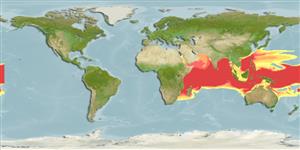>
Gadiformes (Cods) >
Bregmacerotidae (Codlets)
Etymology: Bregmaceros: Greek, bregma = front of the head + Greek, keras, -atos = horn (Ref. 45335).
Eponymy: John McClelland (1805–1875) was a British doctor with interests in geology and natural history. [...] (Ref. 128868), visit book page.
Environment: milieu / climate zone / depth range / distribution range
Ökologie
seewasser; brackwasser; ozeanodrom (Ref. 51243); tiefenbereich 0 - 2000 m (Ref. 26165). Subtropical; 25°N - 6°N, 62°E - 100°E
Indian Ocean: confirmed from the Arabian Sea and Bay of Bengal. Reports from outside this area are most likely misidentifications (A.S. Harold, pers. comm., 18/08/98) and name reported from western Pacific may be a misidentification of B. pseudolanceolatus (Ref. 114229).
Size / Gewicht / Alter
Maturity: Lm ? range ? - ? cm
Max length : 9.6 cm SL Männchen/unbestimmt; (Ref. 4496); common length : 7.0 cm SL Männchen/unbestimmt; (Ref. 2872); max. veröff. Gewicht: 8.50 g (Ref. 128684)
Rückenflossenstacheln (insgesamt) : 0; Rückenflossenweichstrahlen (insgesamt) : 57 - 66; Afterflossenstacheln: 0; Afterflossenweichstrahlen: 58 - 69; Wirbelzahl: 52 - 58. Body is elongate, brownish and with speckling above and silvery below. The cheek and lower head also silver. Single occipital ray long and delicate, extending to near the middle of the second dorsal fin (Ref. 46075). Pelvic fins are jugular.
If taxonomy is correct, both onshore in brackish water and oceanic. According to larval survey, occurrence in the tropics is wide (Ref. 9902, 45075). Feed on planktonic crustaceans. Also caught with bagnets (Ref. 2872).
Life cycle and mating behavior
Geschlechtsreife | Fortpflanzung | Ablaichen | Eier | Fecundity | Larven
Cohen, D.M., 1990. Bregmacerotidae. p. 524-525. In J.C. Quero, J.C. Hureau, C. Karrer, A. Post and L. Saldanha (eds.) Check-list of the fishes of the eastern tropical Atlantic (CLOFETA). JNICT, Lisbon; SEI, Paris; and UNESCO, Paris. Vol. 2. (Ref. 4496)
IUCN Rote Liste Status (Ref. 130435: Version 2024-2)
Bedrohung für Menschen
Harmless
Nutzung durch Menschen
Fischereien: kommerziell
Tools
Zusatzinformationen
Download XML
Internet Quellen
Estimates based on models
Preferred temperature (Ref.
123201): 5.6 - 13.1, mean 8.8 °C (based on 755 cells).
Phylogenetic diversity index (Ref.
82804): PD
50 = 0.5001 [Uniqueness, from 0.5 = low to 2.0 = high].
Bayesian length-weight: a=0.00363 (0.00194 - 0.00680), b=3.16 (2.99 - 3.33), in cm total length, based on LWR estimates for this species & (Sub)family-body (Ref.
93245).
Trophic level (Ref.
69278): 3.3 ±0.42 se; based on food items.
Widerstandsfähigkeit (Ref.
120179): hoch, Verdopplung der Population dauert weniger als 15 Monate. (Assuming tm=1).
Fishing Vulnerability (Ref.
59153): Low vulnerability (10 of 100).
Climate Vulnerability (Ref.
125649): Moderate to high vulnerability (48 of 100).
Nutrients (Ref.
124155): Calcium = 371 [67, 1,117] mg/100g; Iron = 2.89 [0.77, 7.08] mg/100g; Protein = 17.3 [14.9, 19.7] %; Omega3 = 0.283 [0.119, 0.635] g/100g; Selenium = 41.6 [13.0, 146.7] μg/100g; VitaminA = 63.1 [14.0, 271.9] μg/100g; Zinc = 1.04 [0.55, 2.50] mg/100g (wet weight); based on
nutrient studies.
